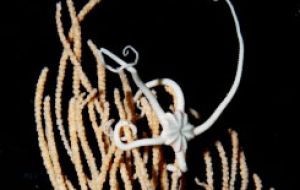MercoPress. South Atlantic News Agency
South Georgia marine biodiversity richer than the Galapagos Islands
 Coral and brittle-star found in the waters of South Georgia Island. (Photo BAS)
Coral and brittle-star found in the waters of South Georgia Island. (Photo BAS) Sea spiders the size of dinner plates and two-meter-long ribbon worms that eat prey several times their own size were among the 1,400-plus species cataloged by the British Antarctic Service in a comprehensive study of marine life around South Georgia Island.
The research shows that, far from being a barren, frozen sea, the area around the sub-Antarctic island teems with life, richer in biodiversity than many tropical sites, including the Galapagos Islands. Many of the species are found nowhere else on Earth.
The research team reported its findings in this week’s edition of the online journal PLoSONE. Since the near-surface ocean waters around South Georgia Island are among the fastest-warming on Earth, the inventory will provide a framework to identify ecologically sensitive areas and species, and to pinpoint conservation priorities and monitor future changes, the scientists said.
South Georgia Island lies remotely east of the tip of South America and northeast of the Antarctic Peninsula.
The temperature of the ocean around Antarctica has increased by an average of 1°C in the last 50 years. The atmospheric temperature on the Antarctica Peninsula has increased by 2.5°C over the same time and is one of the most rapidly warming areas on the planet.
“This is the first time anybody has mapped out the biodiversity of a small polar archipelago in the Southern Ocean,” said lead author Oliver Hogg “If we are to understand how these animals will respond to future change, a starting point like this is really important. The biodiversity of South Georgia exceeds that of its nearest rivals such as the Galapagos and Ecuador in terms of the number of species inhabiting its shores. During the breeding season it hosts the densest mass of marine mammals on Earth,” he said.
The cold, oxygen-rich waters tend to promote growth in marine organisms, so some of the specimens were of extraordinary size, Hogg said in a telephone interview.
“What surprised us the most was the diversity,” he said, explaining that the island’s age (about 45 million years since it separated from the mainland) and its remoteness likely contribute to the richness of marine life. The island is also located at an ocean crossroads of sorts, where larvae can arrive riding ocean currents from both the Antarctic Peninsula and the South American mainland.
The study was funded by the British Government’s Darwin Initiative and the South Georgia Heritage Trust. It included a study of more than 130 years of polar records, and Hogg said ongoing analysis of the results may show how the number and distribution of species has changed in response to climate change that has already occurred in the area.
About 1,445 species were recorded from 17,000 specimens forming part of this study. The research involved the review of more than 25,000 records from polar explorations dating back to Victorian times.
Specimens were collected from scientific cruises, fisheries vessels and by scuba divers from the seas around South Georgia. Species identified include sea urchins, free-swimming worms, fish, sea spiders and crustaceans. Most are rare and many occur nowhere else on Earth.
Data from the study, including information about collections, distribution maps and photos, are compiled online at the South Georgia Marine Biodiversity Database. The study is part of the Darwin Initiative project, collaboration between British Antarctic Survey, the Government of South Georgia and the South Sandwich Islands and the Shallow Marine Surveys Group of the Falkland Islands.




Top Comments
Disclaimer & comment rules-

-

-

Read all commentsA good report showing that these islands need not be thought of simply as 'potential petroleum places'.
May 27th, 2011 - 08:42 pm 0Having been a one-time researcher utilising the 'Behind the Scenes' Antarctic collections of the Natural History Museum in London, it pleases me that these historic collections have been transcribed into patterns of ecological biodiversity.
These published articles and databases will prove valuable also for benchmarking contemporary work on the ecological effects of climate change.
Yes I agree, this is a nice story.
May 27th, 2011 - 09:49 pm 0I've seen some of the Shallow Marine Survey Group's photos and they are truly amazing.
Keep up the good work boys and girls.
So much for Martins assertion that all the BAS is good for is “planting” flags....Excellent efforts from such a small dedicated team.
May 28th, 2011 - 08:39 am 0Commenting for this story is now closed.
If you have a Facebook account, become a fan and comment on our Facebook Page!